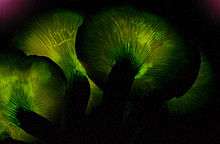Foxfire
 Panellus stipticus, Mt. Vernon, Wisconsin (long exposure) | ||
 Omphalotus nidiformis (seen above), glowing in the dark  A flashlight was used for fill |
Foxfire, also sometimes called "fairy fire", is the bioluminescence created by some species of fungi present in decaying wood. The bluish-green glow is attributed to a luciferase, an oxidative enzyme, which emits light as it reacts with a luciferin. It is widely believed that the light attracts insects to spread spores, or acts as a warning to hungry animals, like the bright colors exhibited by some poisonous or unpalatable animal species.[1] Although generally very dim, in some cases foxfire is bright enough to read by.[2]
History
The oldest recorded documentation of foxfire is from 382 B.C., by Aristotle, whose notes refer to a light that, unlike fire, was cold to the touch. The Roman thinker Pliny the Elder also mentioned glowing wood in olive groves.[3]
Foxfire was used to illuminate the needles on the barometer and the compass of Turtle, an early submarine.[4] This is commonly thought to have been suggested by Benjamin Franklin; a reading of the correspondence from Benjamin Gale, however, shows that Benjamin Franklin was only consulted for alternative forms of lighting when the cold temperatures rendered the foxfire inactive.
After many more literary references to foxfire by early scientists and naturalists, its cause was discovered in 1823. The glow emitted from wooden support beams in mines was examined, and it was found that the luminescence came from fungal growth.[5]
The "fox" in "foxfire" may derive from the Old French word fols, meaning "false", rather than from the name of the animal.[6] The association of foxes with such fires is widespread, however, and occurs also in Japanese folklore.
In popular culture
- In the poem "The Ancient Track" by H. P. Lovecraft fox-fire is seen glowing in field and bog where the narrator is convinced he will find the town of Dunwich.[7]
- Foxfire is a series of books and a magazine focusing on Appalachian culture.[8]
- In the episode "Trapped" of the television series Lassie, Timmy and Boomer look for foxfire to keep girls away from them during Martha Tyson's Halloween Party.[9]
- In the novel Adventures of Huckleberry Finn by Mark Twain, the characters Huckleberry Finn and Tom Sawyer use foxfire as a source of light in order to dig a tunnel.[10]
- In the episode "Our Town" of the television series X-Files, foxfire appears near where a dead body was found in the woods.[11]
- In the Smurfs episode "The Smurf who couldn't say no", Pushover Smurf was instructed to gather foxfire from a marsh for a firefly festival; note that both fireflies' light and foxfire occur due to a single substance, luciferin.
- In the episode "The After School Hexer" of the anime Ghost Hunt, foxfire appears in several rooms of the high school in Mai Taniyama's dream.[12]
- In the romance novel Foxfire Light by Janet Dailey, a horse and its rider are spooked by the light while riding through the woods in the Ozarks.
- In the children's book Rascal by Sterling North, the author describes a phosphorescent stump that gleamed at night with foxfire.
- In the song by John Denver, "Foxfire Suite," foxfire is referenced.
- In an episode of the American situation comedy Small Wonder, Jamie, Harriet, and Vicki use foxfire to see at night when they get lost in the woods while camping. When the foxfire ceases producing light, Vicki uses her robot power to make her hand glow green, causing a surprised reaction from Harriet. Jamie then must hastily explain to Harriet the glow must be due to Vicki spending too much time operating the microwave oven.
- In Guild Wars 2, "Foxfire Clusters" are a rarely occurring material that can be found when harvesting certain types of wood.[13]
- In the trading card game Magic: The Gathering, there is a card named "Foxfire". The card depicts foxfire shining from inside a wooded area. There are also fox tracks in the snow and a silhouette of a fox in the upper left corner.[14]
- Glowing Fungus are a harvestable aid item in the Fallout video game series, most notably in Fallout 3 and Fallout 4.
See also
References
- ↑ "Foxfire:Bioluminescent Fungi". inamidst.com. Retrieved 2011-07-18.
- ↑ "Bioluminescent Fungi". Mykoweb. Retrieved 2011-07-18.
- ↑ "Foxfire: Bioluminescence in the Forest". Warnell School of Forest Resources. Retrieved 2011-07-18.
- ↑ "The Submarine Turtle: Naval Documents of the Revolutionary War". Navy Department Library. Retrieved 2012-05-01.
- ↑ "Bioluminescent foxfire, Bioluminescence facts, Bioluminescent fungi". Journey Idea. Retrieved 2011-07-18.
- ↑ Smythe Palmer, Abram, The Folk and Their Word-lore: An Essay on Popular Etymologies (1904)
- ↑ "The Ancient Track" by H. P. Lovecraft
- ↑ "Foxfire Museum Gift Shop". Foxfire Museum Gift Shop. Retrieved 2016-06-16.
- ↑ "Episode Guide: Season 5 (1958-1959)". Flying Dreams. Retrieved 2011-07-18.
- ↑ Twain, Mark (2011). "35: Dark, Deep-Laid Plans". Adventures of Huckleberry Finn. CreateSpace. ISBN 978-1-4635-2071-7.
- ↑ Stegall, Sarah. "To Serve Man". Munchkyn. Retrieved 2011-07-21.
- ↑ ono, Ono. "Absolute Anime". kodansha. Retrieved 2011-10-15.
- ↑ "Foxfire Cluster". Guild Wars 2 [officiall] Wiki. Arenanet. Retrieved 3 April 2015.
- ↑ "Foxfire". Gatherer. Wizards of the Coast. Retrieved 18 May 2016.
External links
- Foxfire: Bioluminescence in the Forestpdf file by Dr. Kim D. Coder, University of Georgia 8/99
- Bioluminescent Fungi at Mykoweb
